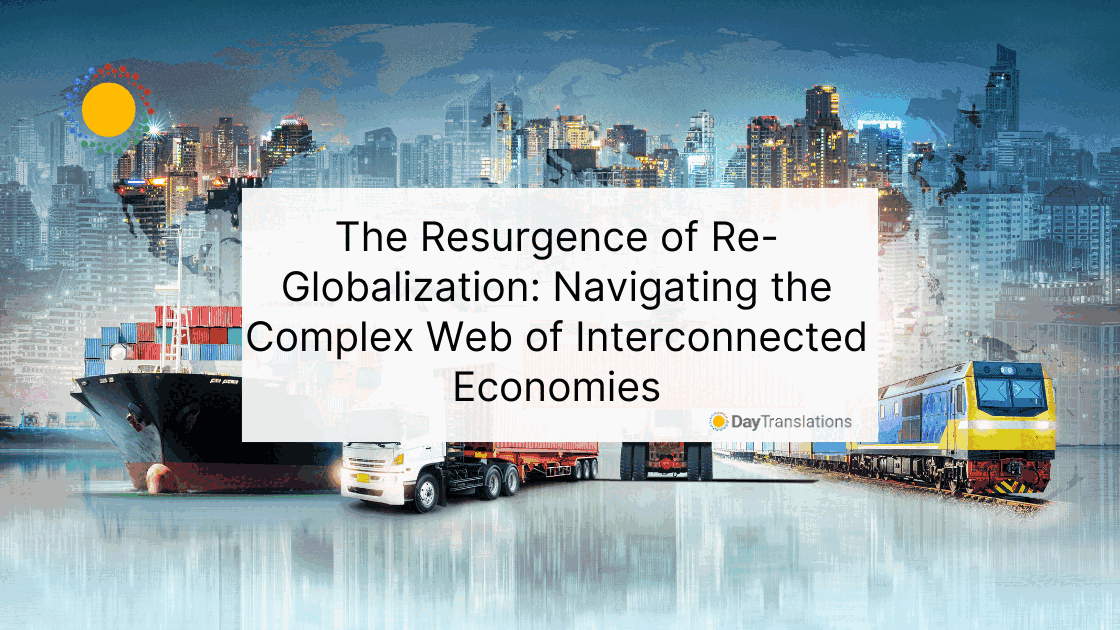The global landscape is undergoing a profound transformation in an era of rapid change. The once-assumed deglobalization trend has given way to a new paradigm – re-globalization. In this article, we delve into the concept of re-globalization, examine its driving forces, and assess its impact on economies, societies, and the world.
The world has witnessed waves of globalization over the past century, from the post-World War II era to the late 20th century when economic integration and interconnectedness reached new heights. However, the early 21st century seemed to signal a departure from this trend, as protectionism, nationalism, and geopolitical tensions threatened to reverse the process of globalization. This phenomenon was often referred to as “deglobalization.”
But as the dust of the early 2000s settled, a surprising development emerged – the resurgence of globalization, albeit in a different form. This new phenomenon has come to be known as “re-globalization.” It represents a complex and dynamic shift in the global landscape, redefining how nations, businesses, and individuals interact and collaborate on the world stage.
Understanding Re-Globalization
Re-globalization, as the term suggests, is the revival and transformation of globalization in response to changing geopolitical, technological, and economic dynamics. It acknowledges the challenges of deglobalization and recognizes the enduring interdependence of nations and economies.
Key Characteristics of Re-Globalization:
Digital Connectivity
The digital revolution has been a driving force behind re-globalization. The internet and advanced communication technologies have facilitated cross-border transactions, enabling businesses to operate globally with ease. Additionally, innovations like transaction categorization API can help businesses classify and manage their cross-border financial interactions more efficiently, further enhancing the seamless nature of global transactions. E-commerce, remote work, and digital finance are just a few examples of how technology has reignited global integration.
Supply Chain Adaptation
The COVID-19 pandemic exposed vulnerabilities in global supply chains. In response, businesses have been reevaluating their supply chain strategies, moving towards diversification and regionalization. This adaptation is not a retreat from globalization but a pragmatic response to enhance resilience.
Green Globalization
Climate change and environmental concerns have prompted nations to collaborate on a global scale to address shared challenges. Agreements like the Paris Agreement exemplify how nations are re-engaging in global cooperation to combat climate change.
Renewed Multilateralism
The decline in unilateralism and the resurgence of multilateral organizations and alliances, such as the World Health Organization and the G7, indicate a shift towards collaborative problem-solving.
Factors Driving Re-Globalization
Several factors contribute to the emergence of re-globalization:
1. Technology Advancements
The digital revolution, characterized by the rapid spread of internet access and mobile technology, has made it easier for businesses to access global markets, communicate across borders, and create international networks.
2. Supply Chain Resilience
The disruption caused by the COVID-19 pandemic highlighted the risks associated with overly centralized supply chains. To mitigate such risks, companies are diversifying their supply sources and adopting technology to enhance supply chain visibility.
3. Environmental Concerns
The urgency of addressing climate change has compelled nations to work together, transcending borders and industries. This collaborative approach is crucial for addressing global environmental challenges effectively.
4. Geopolitical Realignment
Shifts in geopolitical power dynamics have led nations to reevaluate their alliances and partnerships. As traditional alliances evolve, new opportunities for collaboration emerge.
The Impact of Re-Globalization
Re-globalization has profound implications for economies, societies, and geopolitics:
Economic Growth and Innovation
Re-globalization fosters economic growth by increasing market access and promoting innovation. Smaller businesses can participate in global trade, leading to job creation and economic prosperity.
Cultural Exchange
The interconnectedness of languages, cultures, and societies is a hallmark of re-globalization. It facilitates the exchange of ideas, art, and knowledge, enriching the global tapestry of diversity.
Geopolitical Stability
Collaboration on global challenges, such as pandemics and climate change, fosters geopolitical stability by reducing tensions and promoting diplomatic solutions.
Conclusion
Re-globalization represents a dynamic shift in the global landscape, challenging the notion that globalization is in decline. It underscores the enduring interdependence of nations and economies, fueled by technological advancements, supply chain resilience, environmental concerns, and geopolitical realignment. Embracing re-globalization presents opportunities for economic growth, cultural exchange, and geopolitical stability in an increasingly interconnected world.
As we navigate this evolving landscape, it is imperative that nations, businesses, and individuals adapt to the changing dynamics of re-globalization, harness its potential, and address its challenges to build a more prosperous and interconnected future for all.














Sorry, the comment form is closed at this time.